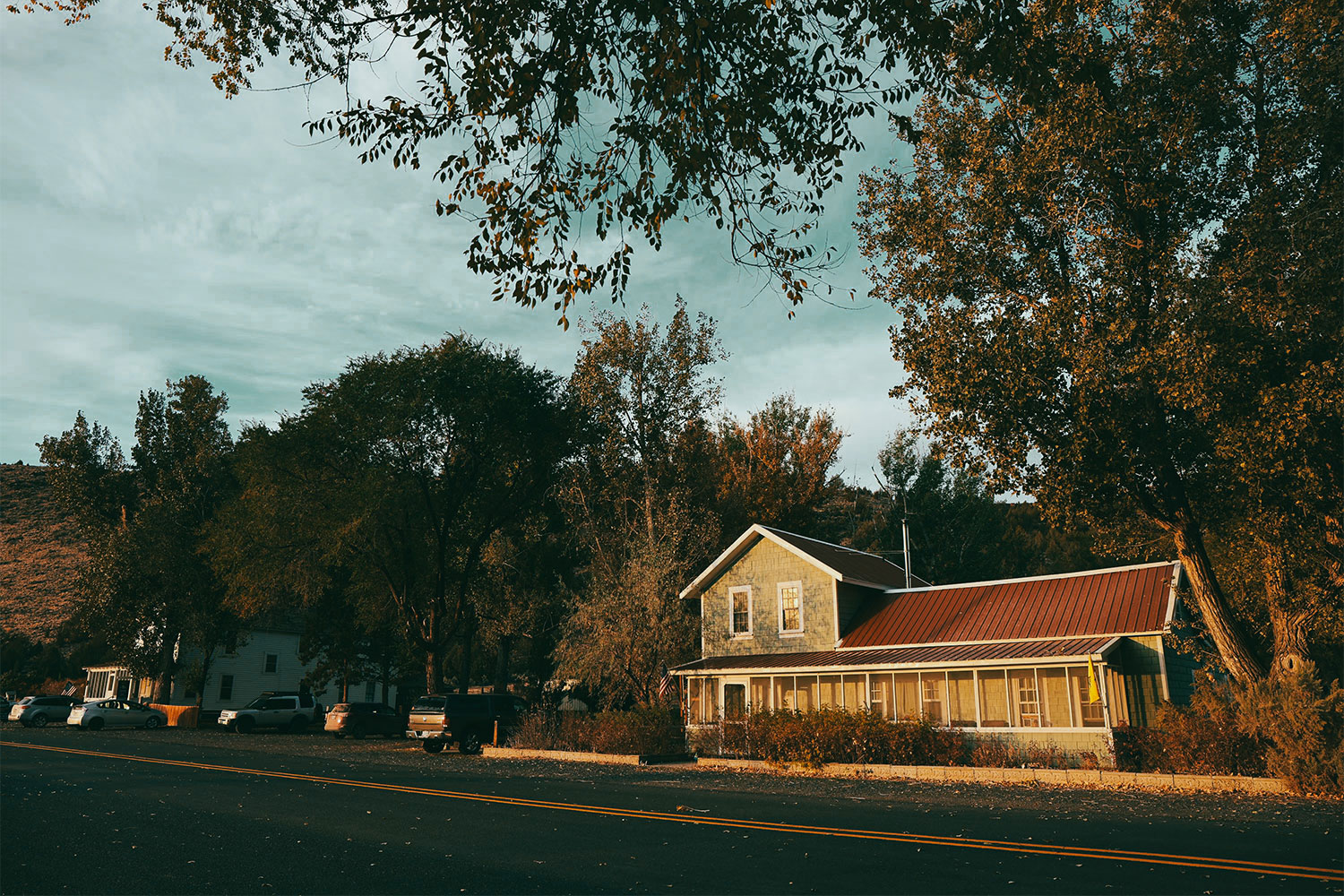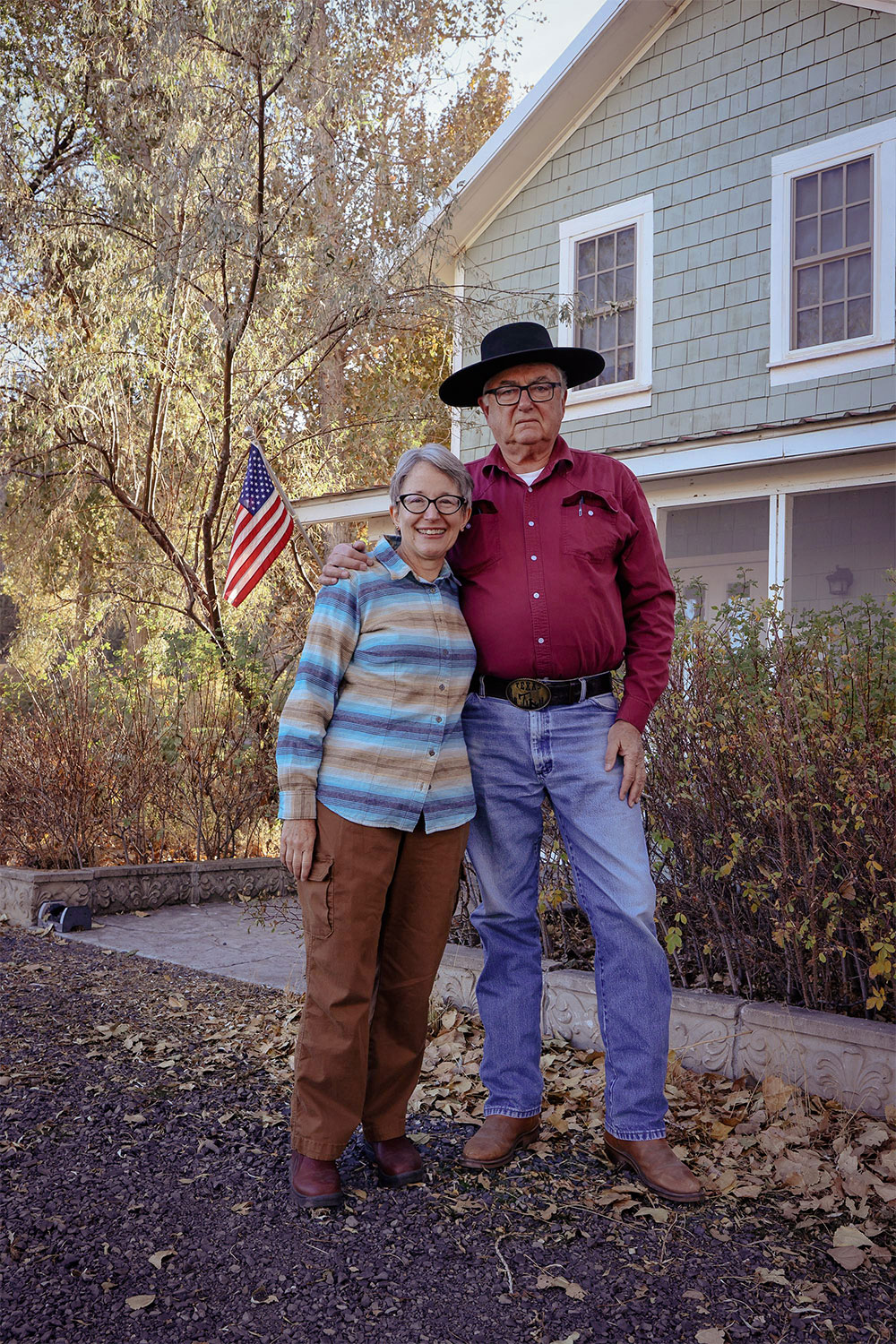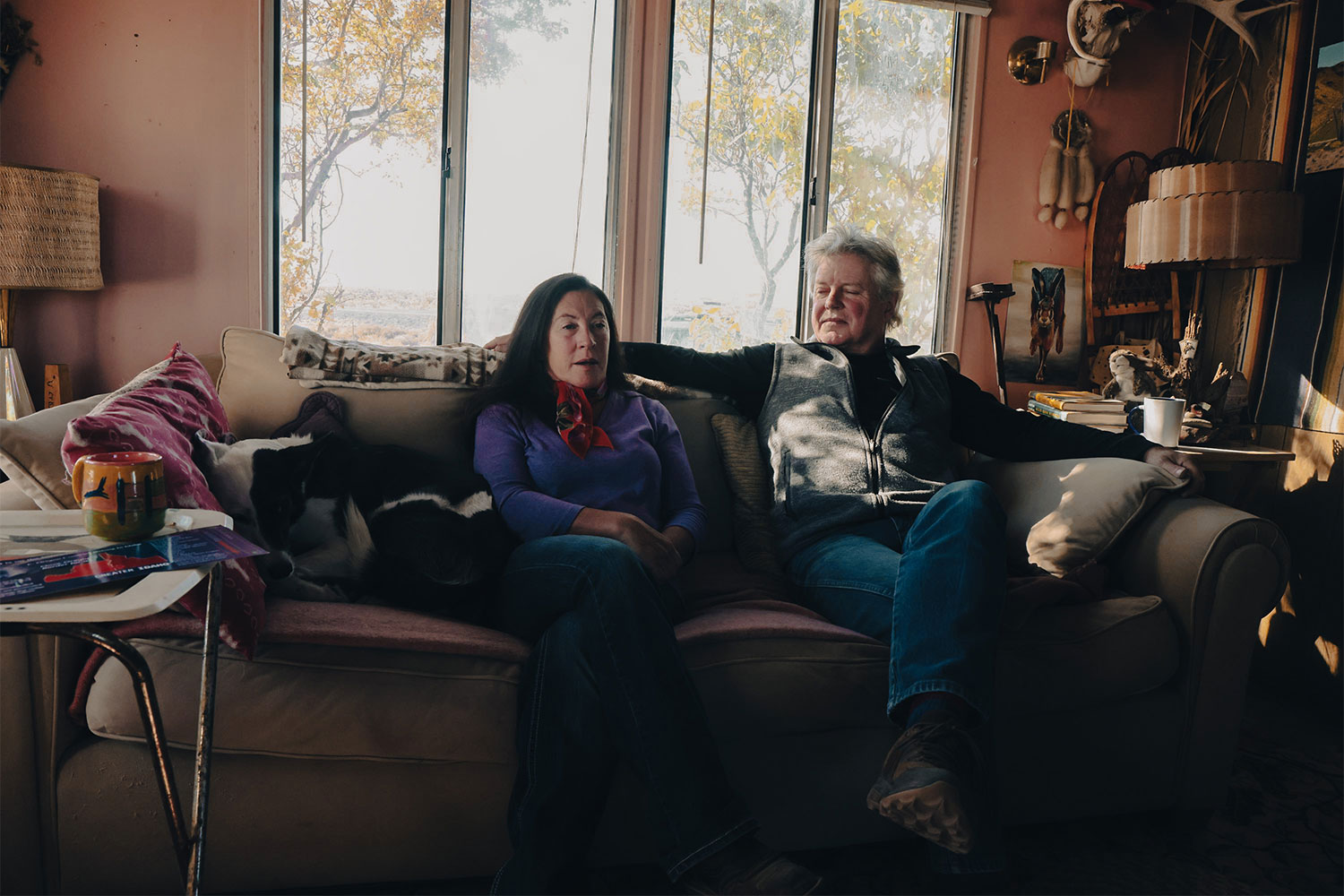Nestled in the sloping tawny hills of eastern Oregon is the community of Frenchglen, home to no more than a dozen houses, the historic Frenchglen Hotel and a school that enrolled just eight students this year. Living in one of these houses is couple Rebekah Lambert, 56, and Mike Fox, 75, former Eugene Symphony leaders who took up a part-time residence on the eastside in 2012 and now live full time across the Cascades from Eugene.
The oldest parts of their sage-green house with a red roof date back to 1890. It’s a P Ranch building, originally owned by the cattle baron Peter French, who was infamously shot and killed by a settler in 1897, though residents of the area speak of the shooting like it was yesterday.
Lambert, who is constantly smiling behind her black cat-eye glasses, and Fox, who wears a semi-permanent scowl and a thick gold belt buckle that says “Texas,” have kept the once-derelict house true to its roots, with hints of their love of both sides of the state sprinkled throughout.
To the left of their door leans a pump shotgun. Lambert, a musician, brings out an old photograph of the Sagebrush Symphony, an early 20th century children’s orchestra based in nearby Burns that toured the state and was a precursor to the Portland Youth Philharmonic. And on the walls hang works of art by Eugene and Corvallis artists.
Oregon is a state geographically, politically and culturally divided by the Cascade Mountains. As you cross the range from west to east, lush forests give way to sagebrush deserts, crowded cities give way to isolated ranches, rain clouds give way to bright blue skies — and Joe Biden signs give way to Donald Trump banners. More than 73 percent of Harney County voters voted for Trump in 2016; in 2020 Trump drew 71 percent of the vote.
Eugene Weekly sat down and talked with three couples who have moved either full or part time from the western part of the state to live in Harney County. While many westsiders choose to stay on the rainy side of the mountains, some are drawn to the wide open spaces and rich local history of the other side, as well as a deep sense of community they find in eastern Oregon. Despite the ongoing pandemic, COVID never came up as a factor in any of their interviews.
Nine years ago, Lambert’s and Fox’s interest in the geologic and historical uniqueness of eastern Oregon led the couple to Frenchglen, where they purchased and renovated their current home. Up until June, they maintained residences in both Frenchglen and Eugene. Now, they’ve sold their home in Eugene and have residences in Frenchglen and Prineville, a small city in central Oregon.
Lambert served as executive director of the Eugene Symphony for seven and a half years, and Fox as a member of the board for 25 years. They still have deep ties in the Eugene area, something Fox calls having “feet in both worlds.” Lambert says that, for the two of them, it doesn’t feel like Oregon’s urban/rural divide exists.
“When we’re talking about the physical landscape, there is no doubt that this is the physical landscape where we feel more at home,” Lambert says. “But otherwise, we go back and forth, and have so many things to love and appreciate on both sides of the mountain.”
Harney County, at 10,226 square miles, is bigger than Connecticut. It’s located in southeastern Oregon and is home to 7,495 residents, according to the 2020 census. That’s fewer than two people per square mile. Lane County, by comparison, has 382,971 people living on 4,772 square miles, or more than 81 people per square mile.
According to IRS migration data, in the 2018-2019 tax year, Harney County net-gained 19 households and 60 individuals from other counties in Oregon. That same year, Lane County net lost 451 households and 617 individuals to other counties in Oregon.
Colby Marshall, a real estate broker at Jett Blackburn Real Estate in Burns, says that the biggest driver from more populated areas to what he calls “frontier Oregon” is the significantly cheaper housing, with three-bedroom, two-bathroom homes in Burns averaging $140,000-$160,000. The median home price in Eugene is $432,000 according to Redfin, a real estate data aggregator.
But there are other, more romantic reasons to seek out the frontier.
“I think the big draws are the fact that they’re smaller communities. The schools are smaller, the class sizes are smaller.” Marshall says. “It’s closer to being out and being able to be on public ground — camping, fishing, hunting, outdoor recreation, mountain biking, you name it.”
Harney County is in the high desert, home to sagebrush, junipers and Ponderosa pines. The expansive horizon line in Frenchglen is obstructed most prominently by Steens Mountain, which stretches some 50 miles north to south.
The county is also home to Malheur National Wildlife Refuge, 187,757 acres of habitat set aside to protect birds. The refuge, which absorbed the P Ranch in 1935, is home to an abundance of birds, including hawks, eagles and pheasants, as well as other creatures like deer, antelope, coyotes and bunnies. Every spring, ardent birders from around the state flock to the Harney County Migratory Bird Festival. In 2016, the refuge was occupied by armed militiamen who pledged to give public lands like the refuge back to the people of Harney County.
A few miles west of Malheur Wildlife Refuge is The Narrows RV Park, a tranquil campground, gas stop, restaurant and saloon hybrid with a Wild West aesthetic that provides the community with a bounty of parking spaces and milkshake flavors.
The Narrows was bought in August 2020 by Tina and Scott Smith, a Salem couple who left the insurance business in search of a fun new start. They had watched the Malheur occupation play out on the news from Salem, but now that they’re living in Harney County and have spoken to people within the community, they say they have a better understanding of what happened and of both sides of the conflict. Right now, they’re trying to stay “neutral” on the subject, and are focused on their new business and new adventure on the eastside.
“We’re calling this our chapter two,” a chipper, curly-haired Tina says from behind the shiny off-white counter in The Narrows cafe. Every few minutes, she turns to help a customer with a block of ice or some other necessity, sometimes greeting them by first name when they step through the door.
Both born and raised in Salem, Tina, 55, and Scott, 61, worked for decades at the insurance agency Scott inherited from his father. Scott worked there for 32 years. Tina joined a few years after Scott started, took time off to raise their family, and rejoined the business before their kids started high school. Eventually, the work became drudgery for both of them. Tina says they wanted to make a change while they were still young, and felt their business experience could be well applied at The Narrows.
As new business owners with a serious lack of employees, the couple say they are working harder than they ever have, averaging 12- to 14-hour work days. And even on their days off, which are few and far between, they’re ordering beverages and scraping down grills. But Scott, who is tall and soft-spoken with an infectious laugh, is of the belief that hard work makes people happy, and running a business at a million miles an hour is how he and Tina thrive.
The atmosphere of Harney County is working for them, too. When talking about his reasons for leaving Salem, the first thing Scott does is gesture out the cafe window to the blue sky extending into the miles-wide horizon.
“You see that?” he says. “Sunshine.”
Despite being relatively new to the area, Scott says he and Tina feel entirely accepted by the community. Because of that, Harney County already feels like home.
“In Salem, it was getting hard to actually know your neighbors. And now, our neighbors are five miles away, but we know them,” Scott says.
“And we know them better than we did the people that lived a block away from us in Salem,” Tina adds. “You know, the world over here is just different.”
Some 30 miles to the north, Sue Arbuthnot and Richard Wilhelm, a couple so in sync they often finish each other’s sentences, maintain lives in both Oregon worlds. Arbuthnot, 63, and Wilhelm, 68, are videographers who split their time between a house in Portland and a single-wide with a salmon-pink living room in the sagebrush flats east of Burns. The other occupant is Mika, their energetic black-and-white mostly border collie dog.
Arbuthnot moved to Burns in 1991, when she was doing work for the U.S. Forest Service. When those projects dried up, she began alternating between teaching in Portland and filming commission work in Burns. The “migratory pattern,” she says, has been established ever since. She met Wilhelm — son of the late science fiction author Kate Wilhelm — in 1999, and the back-and-forth arrangement worked for both of them.
When Arbuthnot and Wilhelm are in Burns, they love to watch the sun rise and set over the flats. They admire the birds and the wildlife. And they appreciate the friendships they’ve nurtured over the last 30 years, and the small but rich community they get to play an active role in.
Currently, their role is as local, in-depth documentarians. For the last six years, Arbuthnot and Wilhelm have been developing what will be a multi-episode docuseries about the 2016 occupation of the Malheur National Wildlife Refuge.
On Jan. 2, 2016, the couple was driving to a birthday party in Burns when they saw a massive group of people in the Safeway parking lot holding flags, banners and posters. This protest marked the beginning of what would become a 41-day occupation of the refuge.
The occupation took place after father-and-son ranchers Dwight and Steven Hammond were resentenced in 2015 to prison for arson on federal land. Far-right activist Ammon Bundy, a car fleet manager from Nevada, took it upon himself to protest the sentencing, starting with the rally at Safeway. About 300 protesters were present, only 50 or 60 of whom were members of the community, according to University of Oregon professor Peter Walker’s book Sagebrush Collaboration: How Harney County Defeated the Takeover of the Malheur Wildlife Refuge. The protest moved to Malheur Wildlife Refuge that night, guns and all.
That first day at Safeway, Arbuthnot and Wilhelm knew something big was unfolding before their eyes, but as members of the community themselves, were unsure of how to get involved.
Then the story went national.
“We did start seeing media arrive from all over the place within a day or so, and realized, if we just leave this in the hands of CNN or whoever’s helicoptering in, we don’t have the opportunity to gather local perspectives,” Arbuthnot says. “And that’s really important to us, because we didn’t want this community to be represented solely by people from outside.”
Arbuthnot and Wilhelm plan to use the documentary as a tool both to undo assumptions about the occupation and to recognize the resonance the event has with the divisions present around the U.S. today. Living in both Portland and Burns, they have a front-seat view of the generalizations people make about their fellow Oregonians on both sides of the mountains.
“When we’re in Portland, we talk to our friends and neighbors there about what things are like here, and they’ll have some pretty wild assumptions,” Arbuthnot says. She says it was especially bad during the occupation itself, when people in Portland were making brash generalizations about ranchers in Harney County. Likewise, during the Black Lives Matter protests in Portland last summer, Wilhelm says that people on the eastside thought that all of Portland was burning to the ground.
Being “bi-local” filmmakers has helped Arbuthnot and Wilhelm to understand the complicated events taking place across the state. They have seen the ways people in the west and the east are entrenched in their identities and beliefs, so much so that they are almost afraid to understand the motivations of one another. And they believe that putting aside these prejudices and learning from people who think differently than they do is a strategy worth applying more broadly.
For others like Lambert and Fox, living with feet in both worlds has only enriched their lives. On the eastside, Fox is heavily involved with the volunteer Rangeland Fire Protection Association, and has used his experience as a lawyer to help them negotiate with the government. On a very local level, before Halloween, a Frenchglen teacher called on Lambert and Fox to make sure they’d be in town for the holiday, since there are so few houses in the community for students to trick-or-treat at.
And last September, Lambert and Fox drove across the mountains for Eugene Symphony’s opening night at the Hult Center, to support a group that they care about in a community that they still love.
Similarly, the “urban/rural divide” is an idea that Arbuthnot and Wilhelm just don’t subscribe to.
“We don’t see a divide,” Wilhelm says. “We see a bridge.”




